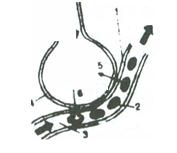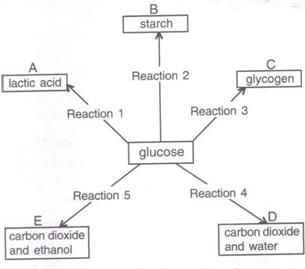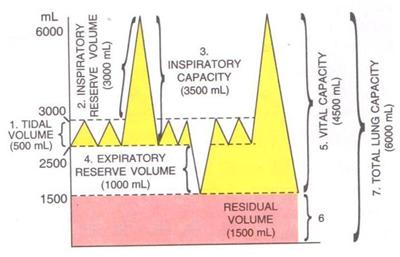Selina ICSE Solutions for Class 9 Biology Chapter 14 - The Respiratory System
Exercise 1
A. Multiple Choice Type
1. During inspiration, the diaphragm
(a) relaxes
(b) contracts
(c) expands
(d) gets folded
2. The ultimate end parts of the respiratory system in humans are known as
(a) alveoli
(b) bronchioles
(c) tracheoles
(d) bronchi
3. During respiration there is
(a) gain in dry weight
(b) loss in dry weight
(c) no change in dry weight
(d) increase in the overall weight
Solution A.1.
1. (b) contracts
2. (a) alveoli
3. (b) loss in dry weight
B. Very Short Type
1. Choose the odd one out in each of the following groups of four items each:
(a) Trachea, Bronchus, Alveolus, Diaphragm
(b) Ethyl alcohol, Carbon dioxide, Starch, Oxygen
(c) Diffusion, Respiratory gases, Alveoli, Capillary network
(d) Trachea, Ciliated epithelium, Mucous, Diffusion
(e)Oxyhaemoglobin, Carbaminohaemoglobin, Hypoxia, Carboxyhaemoglobin
(f) Hairy, Moist, Nostril, Vocal cord
Solution B.1.
(a) Diaphragm
(b) Ethyl alcohol
(c) Diffusion
(d) Diffusion
(e) Hypoxia
(j) Vocal cord
2. Name the body structure concerned with the given functional activity:
(a) Prevents food from entering the trachea during swallowing.
(b) Transports oxygen to the body cells.
(c) Helps to increase the volume of the chest cavity lengthwise.
(d) Combines with the oxygen in the lungs.
(e) Protects the lungs from mechanical injury
(f) Provides actual diffusion of respiratory gases in the lungs.
Solution B.2.
(a) Epiglottis
(b) Capillaries
(c) Diaphragm
(d) Bronchioles
(e) Ribs
(f) Alveoli or air sacs
3.What is the normal percentage composition of gases in inspired and expired air respectively?
Solution B.3.
4. Which chemical compound inside a cell can be termed "Currency of Energy"?
Solution B.4.
ATP or Adenosine Triphosphate is termed as “Currency of Energy” of the cell.
5. Match the items in Column I with the ones most appropriate in Column II. Rewrite the matching pairs.
Column I
|
Column II
|
(a) Alveoli
|
(i) where aerobic respiration takes place
|
(b) Bronchioles
|
(ii) lined with hair
|
(c) Nasal Chamber
|
(iii) diffusion of gases
|
(d) Bronchi
|
(iv) small air tubes
|
(v) an inverted Y shaped tube
| |
(vi) a common passage for food and air
|
Solution B.5.
C. Short Type Answer
1.Given below is an example of certain structure and its special functional activity:
"Kidney and excretion".
Fill in the blanks on a similar pattern.
(a) Alveoli and _____________.
(b) Mitochondria and _____________.
(c) Epiglottis and _____________.
(d) Pleura and _____________.
(e) Diaphragm and _____________.
(f) 'C' shaped cartilage rings and ____________.
Solution C.1.
(a) Alveoli and gaseous diffusion
(b) Mitochondria and power house (respiration)
(c) Epiglottis and guard of entrance to trachea
(d) Pleura and lung covering
(e) Diaphragm and differentiate thoracic cavity and abdominal cavity
(f) ‘C’ shaped cartilage rings and support
2. State one function of each of the following:
(a) Ciliated epithelium lining the respiratory tract
(b) Mitochondria
(c) Diaphragm
(d) Intercostal muscles
(e) Pleural fluid
Solution C.2.
(a) Ciliated epithelium: It is the protective inner lining of the respiratory passage. It helps in motion, driving any fluid that is on them.
(b) Mitochondria: In mitochondria, pyruvic acid is further broken down step by step in a cyclic manner in the presence of oxygen.
(c) Diaphragm: Diaphragm contributes to the enlargement of the chest cavity lengthwise.
(d) Intercostal muscles: The muscles help the inward and outward movement of ribs enlarging the chest cavity all around.
(e) Pleural fluid: It provides lubrication for free movement of the expanding and contracting lungs.
Column A
|
Column B
|
Cartilaginous
|
Epiglottis
|
Large surface area
|
Diaphragm
|
Breathing movements
|
Bronchi
|
Voice
|
Alveoli
|
Complemental air
|
Larynx
|
Swallowing
|
Extra inhalation
|
Solution C.3.
4. Under what conditions would the breathing rate increase?
Solution C.4.
5. How would you prove that air you breathe out is warmer?
Solution C.5.
During breathing, the air expelled out is always warmer or at body temperature. It can be felt by breathing out the air on our own hand. One can feel the warmth of the air expelled out during breathing.
Solution C.6.
The nasal cavity is lined by ciliated epithelium and mucous glands. The mucous glands secrete mucous. The ciliated epithelium is present on the entire lining of larynx, trachea, bronchi and bronchioles. The constant motion of cilia and mucous trap dust, micro-organisms, pollen and other minute particles present in the air. In this way, the respiratory passage is kept free of dust particles.
Solution C.7.
We inhale air which contains more of oxygen and less of carbon dioxide. We exhale air which contains more of carbon dioxide and less of oxygen. Therefore, the statement “We breathe in oxygen and breathe out carbon dioxide” is wrong.
1. Differentiate between the following pairs on the basis of the aspect given in the brackets.
(a) Aerobic and Anaerobic respiration (End products of the process)
(b) Respiration and Photosynthesis (Gas released)
(c) Photosynthesis and Respiration (Reactants)
(d) Inspired air and Alveolar air (CO2 content)
(e) Respiration and Breathing (Organs involved)
(f) Tidal volume and Residual volume (Quantity of air )
Solution D.1.
(a) Aerobic respiration :- CO2, H2O, ATP, Heat energy
Anaerobic respiration :- Lactic acid, ATP, Heat energy
(b) Respiration :- CO2
Photosynthesis :- O2
(c) Photosynthesis :- CO2 + sunlight + H2O
Respiration :- Glucose (with or without oxygen)
(d) Inspired air :- 004%
Alveolar air :- 4.00%
(e) Respiration :- lungs, bronchi, alveoli
Breathing :- nasal cavity, trachea, diaphragm
(f) Tidal volume :- 1500 ml
Residual volume :- 500 ml
2. Give suitable explanations for the following :
(a) Breathing through the nose is said to be healthier than through the mouth.
(b) Why does gaseous exchange continue in the lungs even during expiration?
(c) Why does a person feel breathlessness at higher altitudes?
Solution D.2.
(a) Breathing through the nose is said to be healthier than through the mouth because the hair present in the nostrils prevent large dust particles from entering inside the respiratory system.
(b) Gaseous exchange continues in the lungs even during expiration because expiration is the result of reverse movements of the ribs and diaphragm. As consequence of the movements of the ribs and the diaphragm, the thoracic cavity is diminished and the lungs are compressed, forcing the air out into the atmosphere.
(c) At higher altitudes, the oxygen content of the air is low. So, a person feels breathlessness at higher altitudes.
3. With regard to the respiratory system and the process of respiration in man, answer the following questions:
(a) Name the two muscles that help in breathing.
(b) Briefly describe how the above mentioned muscles help in the inspiration of air.
(c) Give the overall chemical equation to represent the process of respiration in humans.
(d)What is meant by :
1. Residual air and
2. Dead air space
Solution D.3.
(a) (i) Abdominal muscles (ii) Intercostal muscles
(b) (i) The ribs are moved inwards and outwards by the intercostal muscles stretched between them and thereby, enlarges the chest cavity.
(ii) The diaphragm flattens and presses the organs inside the abdomen. When the abdominal muscles relax, the abdominal wall moves outwards.
(c) The overall chemical equation for the process of respiration in humans:
(d)
1. Residual air: Some air is a1ways left in the lungs even after forcibly breathing out. This is the left over or residual air. This volume is 1500 mL.
2. Dead air space: Some tidal air is left in the respiratory passages such as trachea and bronchi, where no diffusion of gases can occur. This volume is called dead air space. It is 150 mL.
4. Starting from the nostrils, trace the path in sequence which the inspired air takes until it reaches the air sacs.
Solution D.4.
Path taken by the inspired air:
Nose → Pharynx → Larynx → Trachea → Bronchi
5. What are the functions of the following in breathing?
(a) Ribs
(b) Diaphragm
(c) Abdominal muscles
Solution D.5.
(a) Ribs: The ribs move inwards and outwards by the muscles stretched between them, thus enlarging the chest cavity all around.
(b) Diaphragm: On contraction, the diaphragm falls or flattens from the dome-shaped outline to an almost horizontal plane and thus, contributes to the enlargement of the chest cavity lengthwise.
(c) Abdominal muscles: Abdominal muscles help to increase the size of the thoracic cavity by the movement of diaphragm and therefore, aids in inspiration.
E. Skill Types
1. Given alongside is a diagrammatic sketch of a kind of part in human lungs.
(i) Name the parts numbered 1-4
(ii)What do the arrows 5 and 6 indicate?
(ii)What do the arrows 5 and 6 indicate?

Solution E.1.
(i) 1: Thin walls of capillary; 2: RBCs (Red blood corpuscles);
3: Plasma; 4: Thin wall of the alveolus
(ii) 5: CO2 diffuses out; 6: O2 diffuses in
2.Given below is an overall chemical reaction of a certain process:

(a) Name the process.
(b) Is this reaction applicable to animals or to plants or to both animals and plants?
(c) Name one tissue in which this reaction occur.
Solution E.2.
(a) Anaerobic respiration
(b) This reaction is applicable to animals only.
(c) This reaction may occur in muscular tissues (skeletal muscles).
3. Given below are chemical reactions (1 to 5) involving glucose and five other chemical products (A-E).

(a) Write the reaction number of the following:
(i) Anaerobic respiration in plants __________
(ii) End products in aerobic respiration ___________
(iii) Reaction occurring in liver _________
(iv) Anaerobic respiration in animals ________
(v) Storage in the liver _________
(i) Anaerobic respiration in plants __________
(ii) End products in aerobic respiration ___________
(iii) Reaction occurring in liver _________
(iv) Anaerobic respiration in animals ________
(v) Storage in the liver _________
(b) Which reactions (1-5) in the above correspond to the following (write the corresponding number of reaction next to them).
(i) Aerobic respiration
(ii) Change taking place in the liver
(iii) Anaerobic respiration in yeast
(iv) Change taking place in a plant
storage organ, e.g., potato
(v) Anaerobic respiration in animals
(ii) Change taking place in the liver
(iii) Anaerobic respiration in yeast
(iv) Change taking place in a plant
storage organ, e.g., potato
(v) Anaerobic respiration in animals
Solution E.3.
(a)
(i) Anaerobic respiration in plants: 5
(ii) End products in aerobic respiration: 4
(iii) Reaction occurring in liver: 2
(iv) Anaerobic respiration in animals: 1
(v) Storage in the liver: 3
(b)
(i) Aerobic respiration: 4
(ii) Change taking place in the liver: 3
(iii) Anaerobic respiration in yeast: 5
(iv) Change taking place in a plant storage organ, e.g., potato: 2
(v) Anaerobic respiration in animals: 1
4.The volume of air in the lungs and the rate at which it is exchanged during inspiration and expiration was measured.
The following diagram shows a group of the lung volumes and capacities.

Study the diagram carefully and explain briefly the following :
(a) Tidal volume (TV)
(b) Inspiratory reserve volume (IRV)
(c) Expiratory reserve volume (ERV)
(d) Vital capacity (VC)
(e) Residual volume (RV)
(b) Inspiratory reserve volume (IRV)
(c) Expiratory reserve volume (ERV)
(d) Vital capacity (VC)
(e) Residual volume (RV)
Solution E.4.
(a) Tidal volume (TV): Air breathed in and out, in a normal quiet breathing is called tidal volume. It is 500 mL.
(b) Inspiratory reserve volume (IRV): Air that can be drawn in forcibly over and above the tidal air is called inspiratory reserve volume. It is also known as complemental air. It is 3000 mL.
(c) Expiratory reserve volume (ERV): Air that can be forcibly expelled out after a normal expiration is called expiratory reserve volume. It is also called supplemental air. It is 1000 mL.
(d) Vital capacity (VC): Volume of air that can be taken in and expelled out by maximum inspiration and expiration is called vital capacity. It is 4500 mL.
(e) Residual volume (RV): Air left in the lungs, even after forcible expiration is called residual volume. It is 1500 mL.
Selina ICSE Solutions for Class 9 Biology Chapter 14 - The Respiratory System



